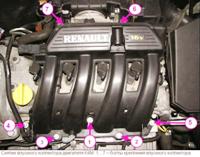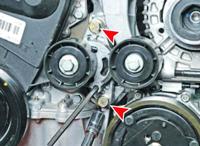In an engine, oil is used to lubricate and cool moving parts
During operation, it becomes necessary to check and top up the oil between oil changes
If the oil consumption exceeds 0.5 liters per 1000 km after the vehicle has been broken in, the cause of the leak or increased oil consumption must be found.
Periodically, and also before each long trip, you need to check the oil level in the engine to avoid breakdown.
Checking the oil level
In order to accurately determine the oil level, you must park the car on a flat horizontal surface and turn off the engine.
This will ensure that all the oil drains into the crankcase.

We take out the oil level indicator (dipstick).
We wipe the pointer with a clean rag and insert it into the guide tube until it stops.
Remove the pointer again and use the edge of the oil film on it to determine the oil level in the engine sump.
The edge of the oil film must be between the two depressions on the index (marks max and min).

The oil level must not exceed the MAX mark and must not fall below the MIN mark.
A low oil level accelerates engine wear and increases the likelihood of engine failure.
When the oil level is exceeded, its waste increases, i.e. the smokiness of the work increases, and the oil darkens faster.
Some of the oil can enter the crankcase ventilation system and enter the combustion chamber, which can also lead to premature wear of the catalytic converter.
Adding engine oil
The vehicle must be on a level, level surface with the engine off.
You need to add oil of the same quality and class as was poured into the engine.
Do not mix mineral and synthetic oils.

Turn counterclockwise and remove the oil filler cap.
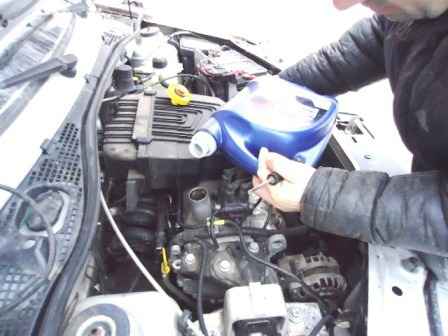
Through the neck, add oil to the engine in small portions.
The difference in the volume of oil filled into the engine between the Min and Max marks is about 1.5 liters.
We wait at least 2-3 minutes for the topped-up portion of oil to drain into the sump, and check the level again.
Changing the oil and oil filter
Oil must be changed after 15 thousand km. car mileage. Again, the same indicator largely depends on the operating conditions and the quality of the oil itself.
We carry out the replacement on a non-working warm engine, best of all after a trip, until the oil has cooled down.
The K7M engine lubrication system includes 3.3 liters of oil.
Engine oils recommended by the factory with an API quality class; SL; SM and SAE viscosity level; 5W30; 5W40; 5W50; 0W30; 0W40.
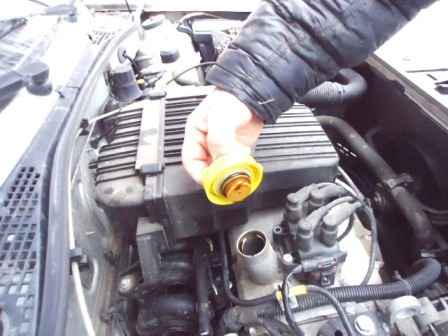
Remove the oil filler cap
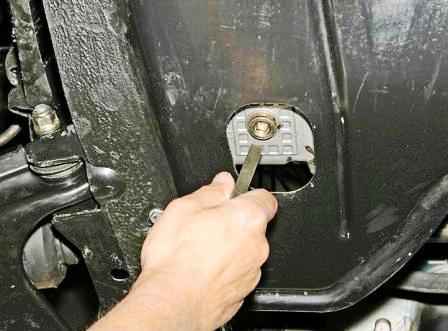
We loosen the drain plug with a four-sided 8.
We substitute a container for draining the oil, preferably wide, with a volume of at least 4 liters.
Unscrew the plug manually and drain the oil.
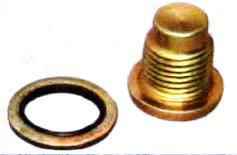
A steel washer is installed under the cork, which is edged with a thin layer of rubber.
If the washer is already warped or missing, you can use a copper or aluminum washer with a diameter of 18 mm.
Wait until the oil drains even completely, and tighten the drain plug.
After that, we proceed to replace the oil filter.
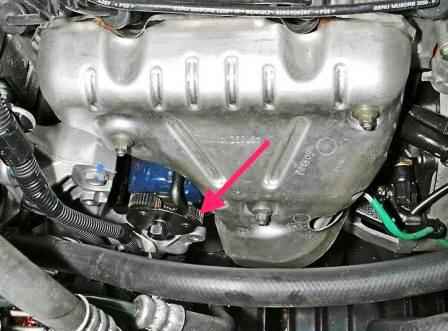
We substitute the container, and unscrew the oil filter.
If it is not possible to unscrew the filter manually, then we use a puller.
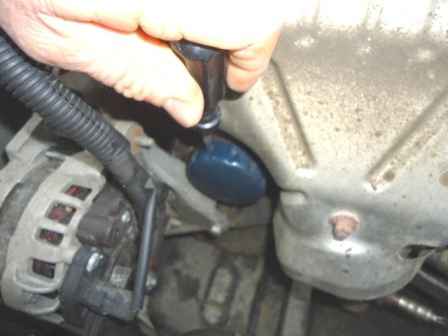
If there is no puller, we pierce the filter with a screwdriver and act as a lever, unscrew the filter.
We clean the filter seat from traces of oil and dirt.
Pour new oil into the filter, and apply a thin layer on the oil filter gasket.
We wrap the oil filter by hand until it is fully tightened. You can't drag the filter.
Pour 3.3 liters of engine oil into the engine through the oil filler neck. Close the oil filler plug.
Start the engine for 1-3 minutes. We make sure that the emergency oil pressure indicator goes out.
We check that there are no oil leaks from under the filter and drain plug.
Stop the engine and after a few minutes check the oil level.









